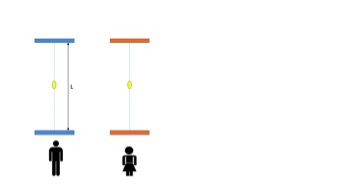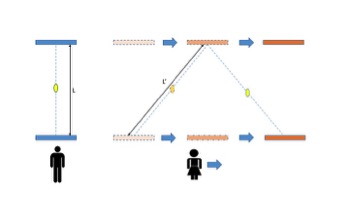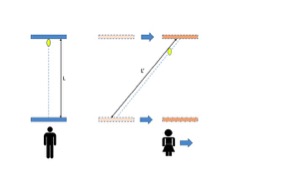
Prompt Images
In Part 1 of this article, we discussed how Einstein’s Relativity has some strange things to say about time. And we also discussed how one of the foundational principles of Relativity is this: Light travels at the same stupidly fast speed of 186,000 mph regardless of how fast the observer is moving.
Now we want to use this fact about light to understand the weird time stuff.
Einstein was not only a genius because of what he figured out, but also how he figured it out. Physics is a field chock-full of smart people using highfalutin mathematics who “discover” new things that only make sense to other people who also understand the same highfalutin mathematics.
But Einstein arrived at many of his most brilliant ideas using simple conceptual pictures that can be intuitively grasped, making these complex concepts accessible to everyone. One such example is the elegant and ingenious “Light Clock,” which Einstein created to explain how time can pass differently for different observers.
To understand his clock, consider first that a clock is any device that records some regularly occurring event, like the pendulum swinging back and forth in a grandfather clock. With this in mind, Einstein proposed the simplest clock possible: two opposing mirrors and a light beam bouncing back and forth between them. Here it is:

Here’s how it works: (A) You fire off a little blip of light (yellow) towards one of the mirrors (blue); (B) you slide the other mirror into an opposing position so the light will bounce endlessly back and forth between the two mirrors; (C) the blip of light reaches the opposing mirror, which counts as one tick in this clock; (D) the blip of light, having bounced off the first mirror, now travels back towards to second mirror; (E) the blip of light hits the second mirror (the tock) before bouncing back to do it all over again.
Tick-tock, tick-tock. And that, ladies and gentlemen, is how you make a clock. And unlike your Apple Watch, this clock is quite useful for understanding the whole time passing differently for different people thing.
Let’s follow Einstein’s argument, shall we?
Imagine two people, Stan and Jan, each having their own light clock. To start, imagine they are both standing still. While they are both standing still there’s no difference between Stan and Jan’s light clocks. The blips of light both travel a similar distance (L), at a similar speed, for every “tick” or “tock” of their respective clocks. While they are standing still like this, their clocks are in sync.

Now let’s change things up a bit. Jan decides she’s over Stan and goes running (with her light clock in hand) at an unfathomably fast speed, like 160,000 mph relative to Stan. From Stan’s perspective, nothing has changed with his light clock. That blip is traveling up and down across the same distance: tick-tock, tick-tock.
But if Stan looks over at Jan, he sees her clock moving, and more importantly, look at the path of that blip of light from his perspective:

As you can see in the picture, the light beam in Jan’s clock has to travel further from Stan’s perspective, since her mirrors are moving sideways as the light beam goes up and down (h/t Pythagoras). Because Einstein says that both light beams travel at the same speed, this means that it must take Jan’s beam of light longer to get to the opposing mirror – in other words, from Stan’s perspective, Jan’s clock is ticking slower.
This is what Stan sees as his beam of light TICKS against his mirror – Jan’s light beam hasn’t TICKed just yet, since it has a little further to travel between mirrors.

Again, if two things are going the exact same speed, but one of them travels further, clearly they must be traveling for different amounts of time.
That’s why Einstein says that time passes differently for people moving at (vastly) different speeds. Because Light Clocks.
This isn’t the whole story – you need a bit more to understand how you go from the above picture to getting twins to age differently. But I think I’ve stretched your brain enough for today. Just rest assured that what I’ve presented here is just part of a long and interesting story. In any case, this argument shows that there is no such thing as a “universal” time that we can all agree on, at least not when people are moving at different speeds. And that, more so than the fact that people can age differently, is one of Einstein’s most fundamental insights about the universe. The rest is detail.
In some ways this shouldn’t be all that surprising. People disagree on things all the time: presidential candidates, whether OJ is guilty, or even whether to call it soda or pop. Einstein is just adding measurements of distance and time to that list. But, he is also giving us something we can always agree on in return – something universal in the purest sense of the word – the speed of light. And shouldn’t that be enough?



